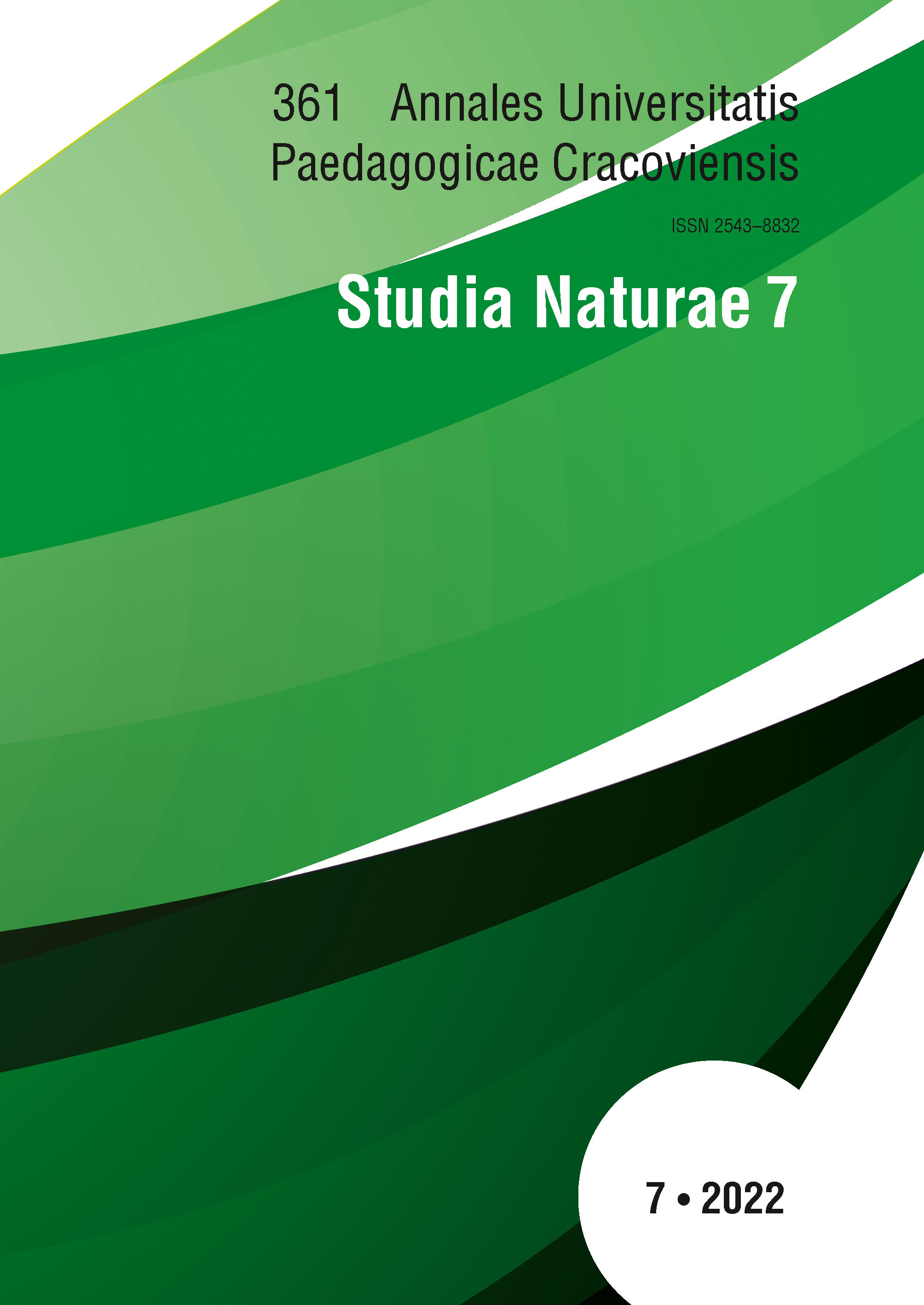Occurrence of the red-leaved rose Rosa glauca Pourr. (Rosaceae), in Poland
DOI:
https://doi.org/10.24917/25438832.7.3Keywords:
Rosaceae, distribution of stands, invasive potential, kenophyteAbstract
The red-leaved rose, Rosa glauca, has the status of an established, non-invasive kenophyte species in Poland. In the 1970s, it was reported to be commonly cultivated, and since the second half of the 20th century, information about its spontaneous spread, mainly in the western part of the country, has appeared in the literature. The aim of this study was to present the current distribution of Rosa glauca sites in Poland. The possible invasive potential of this species was also studied.
Downloads
Metrics
References
Gatunki obce w Polsce (Alien species in Poland). http://www.iop.krakow.pl/ias (access: 2022) [In Polish].
Global Biodiversity Information Facility. https://www.gbif.org/species/3003709 (access: 2022).
Czarna, A. (2009). Rośliny naczyniowe środkowej Wielkopolski (Vascular plants of central Wielkopolska). Poznań: Wyd. Uniwersytetu Przyrodniczego. 184 pp. [In Polish]
Czarna, A. (2016). Roses (Rosa spp.) in old cemeteries in the Wielkopolska region (Poland). Annales Universitatis Mariae Curie-Skłodowska, Sectio C, 71(2), 7–31. https://doi.org/10.17951/c.2016.71.2.7
Dyderski, M.K., Gdula, A.K., Wrońska-Pilarek, D. (2016). Aktualny stan szaty roślinnej terenów wokół jeziora Rusałka w Poznaniu w warunkach antropopresji [Present plant cover of the areas around the Rusałka Lake in Poznań in conditions of human impact]. Acta Scientiarum Polonorum Silvarum, 15(4), 229–246. https://doi.org/10.17306/J.AFW.2016.4.26 [In Polish]
Hobbs, R.J., Humphries, S.E. (1995). An Integrated Approach to the Ecology and Management of Plant Invasions. Conservational Biology, 9, 761–770. https://doi.org/10.1046/j.1523-1739.1995.09040761.x
Lewis, W.H., Ertter, B., Bruneau, A. (2014). Rosa. In: Flora of North America Editorial Committee (eds.), 1993+. Flora of North America North of Mexico. 19+ vols. New York and Oxford. Vol. 9.
Khapugin, A.A., Sołtys‐Lelek, A., Fedoronchuk, N.M., Muldashev, A.A., Agafonov, V.A., Kazmina, E.S., Vasjukov, V.M., Baranova, O.G., Buzunova, I.O., Teteryuk, L.V., Dubovik, D.V., Gudžinskas, Z., Kukk, T., Kravchenko, A.V., Yena, A.V., Kozhin, M N., Sennikov, A.N. (2021). Taxon‐level assessment of the data collection quality in Atlas Florae Europaeae: insights from the case of Rosa (Rosaceae) in Eastern Europe. Nordic Journal of Botany, 39(9), 1–23. https://doi.org/10.1111/njb.03289.
Kościelny, S., Sękowski, B. (1971). Drzewa i krzewy. Klucze do oznaczania. Warszwa: PWRiL. [In Polish]
Piórecki, J. (2013). Rośliny naczyniowe dzikie, zadomowione i uprawowe na Pogórzu Przemyskim. s. 456. Bolestraszyce: Arboretum i Zakład Fizjografii. [In Polish]
Popek, R. (2007). Dziko rosnące róże Europy. Encyklopedia fotograficzna. Kraków: Officina botanica. [In Polish]
Richardson, D. M., Pyšek, P. (2006). Plant invasions: merging the concepts of species invasiveness and community invasibility. Progress in Physical Geography: Earth and Environment, 30, 409–43. https://doi.org/10.1191/0309133306pp490pr
Seneta, W., Dolatowski, J. (2004). Dendrologia. Warszawa: Wyd. Naukowe PWN, s. 282–284. [In Polish]
Sołtys-Lelek, A., Gruszka, W. (2016). Wild roses and hawthorns of urban area: a case study of Piła in Poland. Biodiversity Research and Conservation, 43, 27–40.
Stefanek, W. 1984 (1986). Róże na Pojezierzu Wielkopolskim, między Wartą a Wisłą. Fragmenta Floristica et Geobotanica Polonica, 30(3), 171–184. [In Polish]
Startek, B., Łysko, A. J, Popiela, A. (2020). Flora naczyniowa Pojezierza Myśliborskiego jako efekt przemian antropogenicznych region. Wyd. UŚ. [In Polish]
Szafer, W. (1935). Rodzaj: Rosa L, róża. In: Flora Polska. Rośliny naczyniowe polski i ziem ościennych. Dwuliścienne wolnopłatkowe: dwukwiatowe, 5, 51 pp. Kraków: Polska Akademia Umiejętności. [In Polish]
Szafer, W., Kulczyński, S., Pawłowski, B. (1986). Rośliny polskie, część I. Warszawa: PWN. [In Polish]
Tokarska-Guzik, B., Sajdok, Z., Zając, M., Zając, A., Urbisz, A., Danielewicz, W., Hołdyński, C. (2012). Rośliny obcego pochodzenia w Polsce ze szczególnym uwzględnieniem gatunków inwazyjnych, 197 pp. Warszawa: Generalna Dyrekcja Ochrony Środowiska. [In Polish]
Tutin, T.G., Heywood, V.H., Burges, N.A., Moore, D.M., Valentine, D.H., Walters, S.M., Webb, D.A. (1968). Flora Europaea. Rosaceae to Umbelliferae, 2, 454 pp. Cambridge: Cambridge University Press.
Urbisz, A. (2021). Konspekt flory roślin naczyniowych Wyżyny Śląskiej. Wyd. UŚ. [In Polish]
USDA Plant Hardiness Zone Map (2012). Agricultural Research Service, U.S. Department of Agriculture. Accessed from https://planthardiness.ars.usda.gov/ (access: 2022).
Zając, A., Zając, M. (2001). Distribution Atlas of Vascular Plants in Poland. Cracow: Laboratory of Computer Chorology, Institute of Botany, Jagiellonian University.
Zieliński, J. (1977). Róże Wysoczyzny Lubuskiej. Fragmenta Floristica et Geobotanica Polonica, 23(2), 125–140. [In Polish]
Zieliński, J. (1987). Rosa L. In: A. Jasiewicz (ed.). Flora of Poland, 5, 48 pp. Kraków: Institute of Botany, Polish Academy of Sciences. [In Polish]

